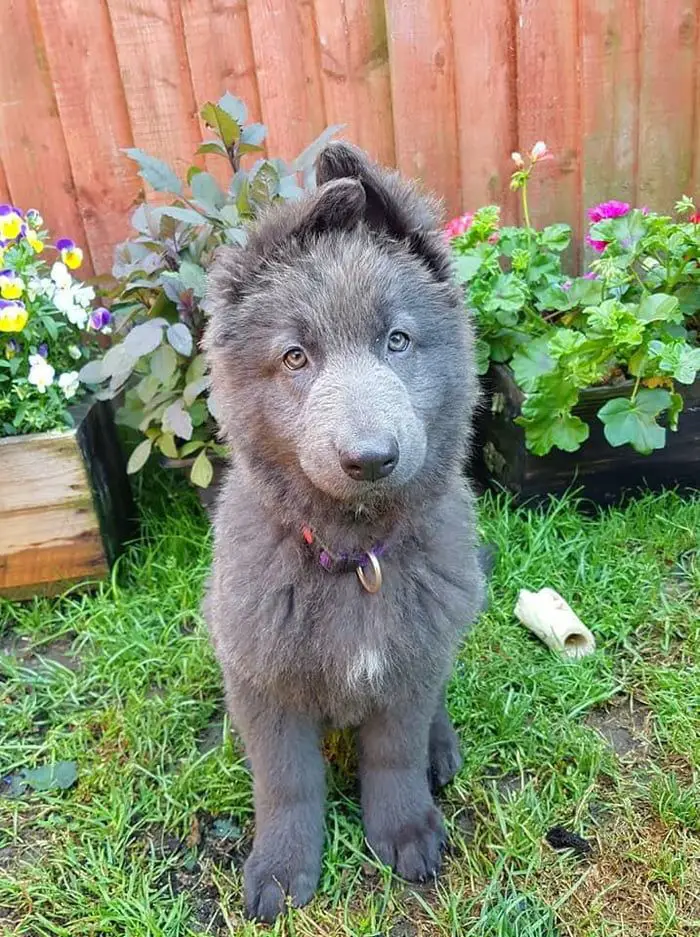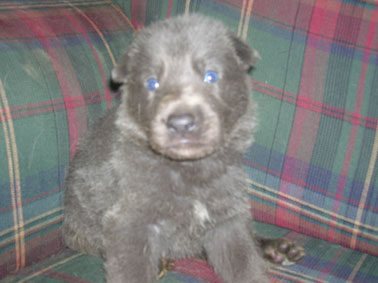The Blue German Shepherd - Everything You Need To Know
Have you ever seen a blue German Shepherd? It's true - there are German Shepherds that are blue. In fact, German Shepherd Dogs come in various colors and also in a lot of different color patterns too.
It is unknown when the first blue German Shepherd appeared, however, according to the “American Kennel Club” (AKC), along with the liver colour, the colour is rare and should be considered a fault for show purposes. There is a lot of controversy within the German Shepherd world on this point, with many believing that despite being blue in colour, they are still purebred GSD’s and as such their color should not be considered a fault.
Others say that the blue colour is simply a gene mutation, and as such the blue German Shepherds should never be bred from, and overtime the gene should be bread out of the species completely.

The blue German Shepherd, technically, a diluted Black Shepherd with 2 recessive genes. It comes from the following gene pairings:
DD – Black traditional German Shepherd
Dd – Black traditional German Shepherd
dd – Blue German Shepherd
Geneticists often use the term “diluted” when referring to the variations in a colour to reflect the “watered down” colour version. The Dd dilution gene affects coat colour in the main, but can also change the colour of eyes and noses.
All coat colours and patterns are controlled by a set or group of genes that work together. In standard German Shepherds you will see descriptions and breakdowns that speak of the A genes, which control the black and red colouring in the dog through the release of melanin, and this affects the generic base colour and variations.
However, the colouring of the blue German Shepherd is controlled by a different gene, the D gene spoken of earlier. It is a gene that is present in all standard German Shepherds and is responsible for both full colour when active, and for diluted when inactive, just like an ‘on and off’ switch.
All genes come in pairs, and it takes the presence of the big D and little d pair to produce the blue German Shepherd. The big D produces full strength coat colour and is the dominant gene, and the little d produces a dilute colour, which is the recessive gene.
For the Blue Shepherd to be created he needs two copies of the diluted recessive gene, one from each parent, in order to have the diluted blue fur. Sometimes GSD’s are bred specially for their blue colour. If both parents have blue fur color their offspring will have it also however it is also possible for the color to appear in regular black and tan German Shepherd Dogs if both parents have the recessive genes.
In addition to the above, the Blue German Shepherd takes three variations in blue colour, they come in blue and black, blue and sable and blue and tan, and again it is all dependent on the mix of different genes.
These mixes in genes are what bring about the various colours of GSDs such as the white German Shepherd, Solid Black German Shepherd, or even the rare black and tan or black and red GSD’s (to name a few).
Additionally, the blue German Shepherd can also be a variety of lighter and darker blues. Steel blue is the darker shade, and powder blue is the lighter of the two. It can be difficult to identify a steel blue on his own, but when you stand him next to a black German Shepherd, you can easily tell the difference in colour.

How do they look?

If you've never seen one of these dogs just imagine that everywhere there is black on the GSD normally, that you now see kind of a dusty grey colour. Everywhere there's normally a tan colour on a German Shepherd appears really “washed out”, kind of a grey colour or almost blue looking in appearance.
In some cases the blue might look kind of dusty, like someone spilled flour on the dog's coat but then in other cases it might be more of a darker gunmetal colour.
Although it is rare and frowned upon by the AKC don't let the blue colour scare you away. A healthy blue German Shepherd is a very handsome animal and has all the same loyal and intelligent traits as regular colored German Shepherds.
Blue German Shepherds In Competition
According to the American Kennel Club the blue colour is a “serious fault” in their genes, and whilst they can still be entered into activity events, they are rarely seen because standard black and tan German Shepherds are favoured. Many owners who have an unfavourably coloured German Shepherd have suggested that their pups face colour discrimination in events even in competitions where color should not be judged.
As a general rule you won’t really see blue German Shepherd Dogs competing in many national events
Blue German Shepherd Traits
Other than the colour of their coat, the blue German Shepherd will follow the same characteristics of any standard German Shepherd.
The males will weigh between 65 and 90 pounds, and they will measure 24 to 26 inches in height from paw to shoulder, also known as the withers. The females will weigh between 50 and 70 pounds and will measure 22 to 24 inches at the withers. In addition to the blue, the German Shepherd’s coat can also be Gray, Sable, White, Black, Black and Red, as well as other variations of these coats.
Additionally, it is common for the blue German Shepherd to have lighter coloured eyes, such as light blue, golden brown or yellow compared to the darker eyes of normal colored German Shepherds. Again, this is controlled by the recessive genes explained above.
Because of their appearance, the blue German Shepherd is often mistaken for a blue Malinois, or with yellow eyes can often look similar to a dark grey wolf.
Around The Home
The German Shepherd is a favoured family pet across the globe, and this is no different for the blue German Shepherd. They are super affectionate with their immediate family and enjoy a cuddle on the sofa and lounging around home. It’s not uncommon for a GSD to attach themselves to one person in the family in particular.
The blue German Shepherd is known for their confident and courageous personality. If properly trained and socialized their natural guarding tendencies work great in a home environment. Blue German Shepherds can also be aloof with strangers, or outsiders of the pack if improperly socialized but if raised correctly they are lovely, loyal dogs.
The blue German Shepherd, like any other German Shepherd, is a medium energy dog and requires up to 60 minutes of exercise a day. High intensity exercise that tests their mental abilities as well as their physical are their favorite.
Your dog would also require mental stimulation throughout the day, such as playing interactive games with his you, patrolling the yard, or taking part in training sessions. Because of their guarding tendencies early socialization is key to a happy hound and household! Due to their large size it is critical for young GSD’s to be exposed to a variety of situations and range of sounds, as well as other dogs of all shapes and sizes.
You’ll want to make sure that you train your blue GSD properly. They are working dogs, and they like to pull if they are not trained properly. We also recommend crate training from a young age.
Health Characteristics Of A Blue German Shepherd Dog
The blue GSD has the same health tendencies as the normal black and tan variants, and their lifespan is 7 to 10 years.
Unlike other breeds, such as the French Bulldog, the colour blue is not indicative of health issues or problematic personality traits. The diluted gene is often linked to health issues in other breeds, such as Colour Dilution Alopecia in Weimaraner, but the blue German Shepherd is not known to suffer any diluted colour related health issues. Simply put, the blue German Shepherd is simply a colour variation, and their health is exactly the same as a traditional coloured German Shepherd.
If looking at buying a puppy the National Breed Club for the German Shepherd recommends that both parents are tested for Elbow and Hip Dysplasia, and that they should both score at least “Fair”. Elbow and Hip Dysplasia is an abnormal formation in the elbow and hip joints which is prevalent in larger breeds of dogs. Over time this formation can cause pain in their joints and can often lead to crippling arthritis in older dogs.
Feeding A Blue German Shepherd
The blue German Shepherd will eat, on average, between 3 to 4 cups of dry food a day. Because German Shepherds are susceptible to bloat, it is advised to spread food across several sittings during the day. The exact amount of food will vary on the size of your dog and their activity levels throughout the day.
Grooming
The blue GSD often has a medium length outercoat with a dense undercoat. Due to the thick undercoat, they are heavy shedders. To keep their coat nice throughout the year you will need to brush them 2 or 3 times a week. During shedding season you will need to brush them every day.
You should wash your GSD every 6 to 8 weeks to keep the coat clean and help with shedding. Specialist dog shampoos and shedding products help make managing the coat easier. It is possible for blue German Shepherds to have a long coat but it is very rare.
Cost Of A Blue German Shepherd
Buying from a reputable breeder a blue German Shepherd will cost, on average, no more than a traditional GSD. This cost is usually around $1200 - $1500 and up. Because their colour is more on the rare side, you may end up paying a slightly higher premium for this colour of the breed.
These dogs are rarer than their tan and black saddle siblings (i.e. the traditional GSD appearance) and not a lot of breeders aim for this unique colour. This can make it difficult to find one to buy. German Shepherds are larger dogs, and can have large litter sizes. With an average of eight puppies in a litter; a blue German Shepherd puppy may show up unexpectantly.
Adult German Shepherds, who are proven show dogs, may sell for between $7,000 and $9,000 USD. The AKC has a list of AKC accredited breeders that makes it easier to find a reliable breeder in your area. If you would prefer to adopt, the German Shepherd Club of America has a list of available rescues and rescue centres all over the country.
Adopting A Blue German Shepherd
On the other hand, if you are considering rescuing a German Shepherd, then the American German Shepherd Rescue Association has listed rescue centres dedicated to this breed and you may find some blues that need a home. With rescue costs being, on average, between $50 and $350, you will be saving a life, and saving money that you can spend on extra toys.
Finishing Up
Blue German Shepherds make great family pets. They are fun, intelligent, trainable, affectionate, loyal and protective. If they are socialized from a young age, they are great with children and other pets and will be a lovely member of the family for years.
Naturally, all dogs have their own quirks that make them unique, just like all humans, and a blue GSD will be no different. Generally, however, German Shepherds are intelligent and fun to be around and love to spend hours playing in the garden with their family.
If you do adopt one of these beautiful pups then it might be wise to let your neighbours know so that they think you have a stray wolf in your yard! Apart from looks though you’ll end up with the same loyal, intelligent and loveable GSD as everybody else.
For more information about the blue German shepherds, you can consult different social networks of groups responsible for the upbringing and care of the GSD, like the American Blue Bay Shepherd Association.
Sign up for promotions, news, discounts, and the chance to win prizes for you and your German Shepherd
